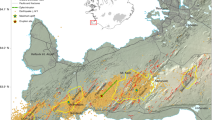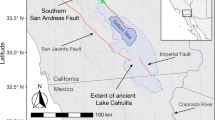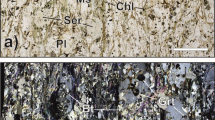Abstract
Two of the most often cited earthquake precursors are radon emanation and electric potential variations1,2,3,4,5,6, but these few reported examples have generally been deemed questionable7,8,9,10,11. If a mechanism relating crustal deformation to radon emanation or electrical signals does indeed exist, it is thought to involve fluids12,13,14,15,16,17,18,19. Some preliminary insight has been gained into these processes from the study of natural systems under controlled mechanical and hydrological conditions20. Here we report electric potential variations, radon emanation and deformation measurements recorded since 1995 in the French Alps in the vicinity of two artificial lakes which have strong seasonal variations in water level of more than 50 metres. We observe that electric potential variations and radon emanations are repeatedly associated with transient deformation events induced by variations in lake levels. These events are characterized by a change in ground tilt which deviates from the expected elastic response, and are associated with periods of accelerating strain, which suggests that accelerated loading can enhance fluid transport properties. Qualitatively, this behaviour can be accounted for by a model in which straining induces fluid overpressure and dynamic flow in cracks. These observations mayshed light on the sensitivity of rock transport properties to deformation.
This is a preview of subscription content, access via your institution
Access options
Subscribe to this journal
Receive 51 print issues and online access
$199.00 per year
only $3.90 per issue
Buy this article
- Purchase on Springer Link
- Instant access to full article PDF
Prices may be subject to local taxes which are calculated during checkout




Similar content being viewed by others
References
Wakita, H., Nakamura, Y. & Sano, Y. Short-term and intermediate-term geochemical precursors. Pure Appl. Geophys. 126, 267–278 (1988).
Igarashi, G. et al. Ground-water radon anomaly before the Kobe earthquake in Japan. Science 269, 60–61 (1995).
Virk, H. S. & Singh, B. Radon recording of Uttarkashi earthquake. Geophys. Res. Lett. 21, 737–740 (1994).
Raleigh, B. et al. The prediction of the Haicheng earthquake. Eos 58, 236–272 (1977).
Corwin, R. F. & Morrison, H. F. Self-potential variations preceding earthquakes in Central California. Geophys. Res. Lett. 4, 171–174 (1977).
Varotsos, P., Alexopoulos, K. & Lazaridou, M. Latest aspects of earthquake prediction in Greece by seismic electric signals, II. Tectonophysics 224, 1–37 (1993).
Geller, R. J. (ed.) Geophys. Res. Lett. 23(debate on “VAN” special issue) 1291–1452 (1996).
Pham, V. N., Boyer, D., Chouliaras, G., Le Mouël, J. L. & Rossignol, J. C. Characteristics of electromagnetic noise in the Ioannina region (Greece); a possible origin for so called “Seismic Electric Signal” (SES). Geophys. Res. Lett. 25, 2229–2232 (1998).
Morrison, H. F., Fernandez, R. & Corwin, R. F. Earth resistivity, self potenial variations, and earthquakes: a negative result for M = 4.0. Geophys. Res. Lett. 6, 139–142 (1979).
Geller, R. J. Earthquake prediction: a critical review. Geophys. J. Int. 131, 425–450 (1997).
Wyss, M. Second round of evaluations of proposed earthquake precursors. Pure Appl. Geophys. 149, 3–16 (1997).
Scholz, C. H., Sykes, L. R. & Aggarwal, Y. P. Earthquake prediction: a physical basis. Science 181, 803–810 (1973).
Igarashi, G., Wakita, H. & Sato, T. Precursory and coseismic anomalies in well water levels observed for the February 2, 1992 Tokyo Bay earthquake. Geophys. Res. Lett. 19, 1583–1586 (1992).
Roeloffs, E. A. Hydrologic precursors to earthquakes: a review. Pure Appl. Geophys. 126, 177–209 (1988).
Muir-Wood, R. & King, G. C. P. Hydrological signatures of earthquake strain. J. Geophys. Res. 98, 22035–22068 (1993).
Mizutani, H., Ishido, T., Yokotura, T. & Onishi, S. Electrokinetic phenomena associated with earthquakes. Geophys. Res. Lett. 3, 365–368 (1976).
Jouniaux, L. & Pozzi, J. P. Streaming potential and permeability of saturated sandstones under triaxial stress: consequences for electrotelluric anomalies prior to earthquakes. J. Geophys. Res. 100, 10197–10209 (1995).
Bernard, P. Plausibility of long distance electrotelluric precursors to earthquakes. J. Geophys. Res. 97, 17531–17546 (1992).
King, C. Y. Gas geochemistry applied to earthquake prediction: an overview. J. Geophys. Res. 91, 12269–12281 (1986).
Morat, P. & Le Mouël, J. L. Electrical signals generated by the collapse of the pillars of a gypsum quarry. C.R. Acad. Sci. 308, 33–38 (1989).
Perrier, F. et al. Aone-year systematic study of electrodes for long period measurement of the electric field in geophysical environments. J. Geomagn. Geoelectr. 49, 1677–1696 (1997).
Wilkening, M. H. & Watkins, D. E. Air exchange and 222Rn concentrations in the Carlsbad caverns. Health Phys. 31, 139–145 (1976).
Direction de l'Equipement Electricité De France, Note de synthèse géologique et technique, Barrage de Roselend, Fondation de l'Ouvrage 1–12;, (Electricité De France, Aix-en-Provence, (1952–1962). (In French.)
Roeloffs, E. A. Fault stability changes induced beneath a reservoir with cyclic variations in water level. J. Geophys. Res. 93, 2107–2124 (1988).
Perrier, F., Trique, M., Hautot, S., Avouac, J. P. & Tarits, P. Electrical variations associated with yearly lake level variations. Geophys. Res. Lett. 25, 1955–1958 (1998).
Simpson, D. W. & Negmatullaev, S. K. Induced seismicity at Nurek Reservoir, Tadjikistan, USSR. Bull. Seismol. Soc. Am. 71, 1561–1586 (1981).
Gupta, H. K. Induced seismicity hazard mitigation through water level manipulation at Koyna, India: a suggestion. Bull. Seismol. Soc. Am. 73, 679–682 (1983).
Silver, P. G. & Valette-Silver, N. J. Detection of hydrothermal precursors to large Northern California earthquakes. Science 257, 1363–1367 (1992).
Rojstaczer, S., Wolf, S. & Michel, R. Permeability enhancement in the shallow crust as a cause of earthquake-induced hydrological processes. Nature 373, 237–239 (1995).
Petiau, G. In Proc. of the Workshop “Electrodes” (eds Clerc, G., Perrier, F., Petiau, G. & Menvielle, M.) (Report, Centre de Recherches Geophysiques de Garchy, (1996).
Acknowledgements
We thank Y. Caristan, A. Meesters and R. Pican for support, and EDF for its water level data and access to the lakes. We also thank the members of the technical team from the Département Analyse et Surveillance de l'Environment, CEA, for their dedication in performing their work in often difficult weather conditions.
Author information
Authors and Affiliations
Corresponding author
Supplementary information
Rights and permissions
About this article
Cite this article
Trique, M., Richon, P., Perrier, F. et al. Radon emanation and electric potential variations associated with transient deformation near reservoir lakes. Nature 399, 137–141 (1999). https://doi.org/10.1038/20161
Received:
Accepted:
Issue Date:
DOI: https://doi.org/10.1038/20161
This article is cited by
-
Time-series analysis of radon monitoring in soil gas in association with earthquakes in Stivos faulting, at Lagadas basin, North Greece
Journal of Radioanalytical and Nuclear Chemistry (2023)
-
Radon transport carried by geogas: prediction model
Environmental Science and Pollution Research (2023)
-
The effect of environmental parameters on radon concentration measured in an underground dead-end gallery (Vyhne, Slovakia)
Journal of Radioanalytical and Nuclear Chemistry (2023)
-
Observations on the stress related variations of soil radon concentration in the Gulf of Corinth, Greece
Scientific Reports (2022)
-
Non-normal distribution of radon and residual radon and short-term abnormal precursors of residual radon before major earthquakes
Earth Science Informatics (2022)
Comments
By submitting a comment you agree to abide by our Terms and Community Guidelines. If you find something abusive or that does not comply with our terms or guidelines please flag it as inappropriate.



